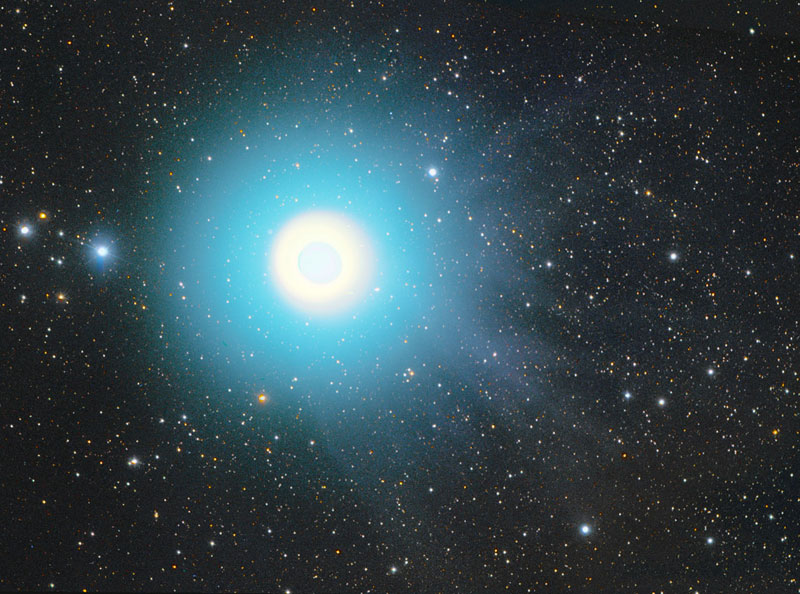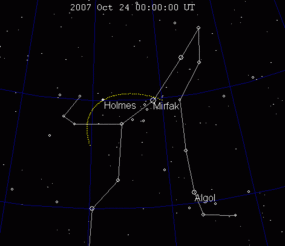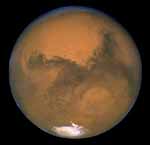Comet Holmes 17/P Bigger
Than The Sun
The comet 17P/Holmes
has astronomers around the world scratching their heads in confusion. The
heavenly body just keeps getting bigger -- and is now twice the diameter
of our sun.
17P/Holmes is a periodic
comet in our solar system, discovered by the British amateur astronomer
Edwin Holmes on November 6, 1892. In only 42 hours in October 2007, the
comet brightened from a magnitude of about 17 to about 2.8. This represents
a change of brightness by a factor of about half a million and is the largest
known outburst by a comet.
On November 9, 2007 the
coma, the thin dissipating dust ball around the comet, was found to be
the largest object in the solar system, with a diameter greater than that
of the Sun. (Though by Solar System standards, the mass of the comet is
minuscule.)
Comet 17P/Holmes was discovered
by Edwin Holmes on November 6, 1892 while he was conducting regular observations
of the Andromeda Galaxy (M31). Its discovery in 1892 was made because of
and during magnitude changes similar to the 2007 outburst. 17P/Holmes brightened
to an approximate magnitude of 4 or 5 before fading from visibility over
a period of several weeks.
|
|

The comet's discovery
was confirmed by Edward Walter Maunder (Royal Observatory, Greenwich, England),
William Henry Maw (England), and Kidd (Bramley, England) and independent
discoveries were made by Thomas David Anderson (Edinburgh, Scotland) on
November 8 and by Mike Brown , (Wilkes) , (USA) and by John Ewen Davidson
(Mackay, Queensland, Australia) on November 9. |
The first calculations of
the elliptical orbits of 17P/Holmes were done independently by Heinrich
Kreutz and George Mary Searle. Additional orbits eventually established
the perihelion date as June 13 and the orbital period as 6.9 years. These
calculations proved that the comet was not a return of 3D/Biela.
The 1899 and 1906 appearances
were observed, but the comet was lost after 1906 until recovered on July
16, 1964 by Elizabeth Roemer (US Naval Observatory, Flagstaff, Arizona,
USA). Aided by the computer predictions of Brian G. Marsden, the comet
has been observed on every subsequent return.
The comet has an orbital
period of 6.8 years. It last reached perihelion, its closest approach to
the Sun, on May 4 2007. At that time, it was 2AU (186 million miles) from
the sun.
Today, the comet is about
1.6AU (149 million miles) from Earth and about 2.4AU (223 million miles)
from the Sun.
The comet's nucleus is
believed to measure only about 3.5 km in diameter.

The comet was discovered
November 6 1892 by Edwin Holmes in London. Before its recent outburst,
it was only magnitude 17, and barely visible in a large telescope. On October
23 2007 the comet unexpectedly brightened to magnitude 2.5 and became visible
to the naked eye in the constellation Perseus.
2007 outburst
Between October 23–24,
2007, Comet Holmes grew much brighter, going from about magnitude 17 to
about magnitude 2.8 in just 42 hours. The first person reportedly to notice
a change was J. A. Henríquez Santana on Tenerife in the Canary Islands;
minutes later, Ramón Naves in Barcelona noticed the comet at magnitude
7.3. It became easily visible to the naked eye as a bright yellow "star"
in Perseus, and by October 25 17P/Holmes appeared as the third brightest
"star" in that constellation.
While large telescopes
showed fine-scale cometary details, naked-eye observations gave a view
similar to that of a star until October 26. After that date, 17P/Holmes
began to appear more comet-like to naked-eye observers. During the comet's
outburst, its orbit took it to near opposition with respect to Earth, and
since comet tails point away from the Sun, Earth observers were looking
nearly straight down along the tail of 17/P Holmes, making the comet appear
as a bright sphere.
 |
Based on orbital computations
and luminosity before the 2007 outburst, the comet's nucleus was estimated
at 3.4 km. In late October 2007 the coma's diameter increased from 3.3
arcminutes to over 13 arcminutes, about half the diameter that the Moon
subtends in the sky. At a distance of around 2 AU, this means that the
true diameter of the coma swelled to over 1 million km, or about 70% of
the diameter of the Sun. By comparison, the Moon is 380,000 km from Earth.
Therefore, during the 2007 outburst of Comet Holmes the coma was a sphere
wider than the diameter of the Moon's orbit around Earth. On 2007 November
9, the coma had dispersed to an area larger than the sun, briefly giving
it the largest extended atmosphere in the solar system.
The cause of the outburst
is not definitely known. The huge cloud of gas and dust may have resulted
from a collision with a meteoroid, or, more probably, from a build-up of
gas inside the comet's nucleus which eventually broke through the surface |
......Back |
|




